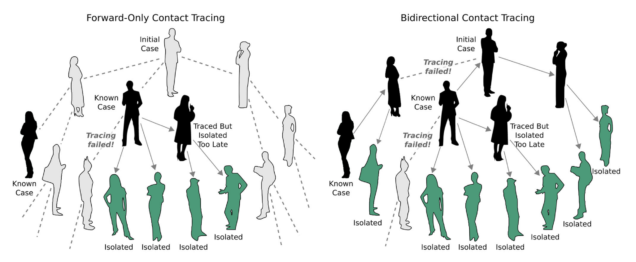On January 17, Massachusetts confirmed the presence of the more contagious strain of SARS-CoV-2, known as B-117, that first surfaced in the United Kingdom. With the strain likely to speed up the rate of transmission across the region, current contact tracing methods might be insufficient in preventing its spread throughout the commonwealth. But a solution may be within grasp.
New research from Boston University, Massachusetts Institute of Technology, North Carolina State University, and Max Planck Institute for Biology of Ageing suggests that "bidirectional" contact tracing-the practice of tracking positive COVID-19 cases to recently exposed individuals and back to their original source-can be twice as effective as current contact tracing methods, which only focus on identifying who the newly diagnosed individual may have infected, but not who infected them. The research team's findings were recently published in Nature Communications.
Jonathan Huggins, a BU College of Arts & Sciences assistant professor of mathematics and statistics, worked closely with collaborators to build a model that explores the effectiveness of bidirectional contact tracing. While the spread of coronavirus has bloomed at an alarming rate across the United States, the team raced to collect data and analyze their results in just one month. Based on their analysis, Huggins and his team believe that bidirectional contact tracing, though more time-intensive than conventional tracing methods, could help prevent the spread of the more infectious B-117 strain.
Bidirectional contact tracing adds a step of "reverse tracing" to find the person that infected the known case-called the "infector"-and then all of the individuals that original person might have infected. "Bidirectional contact tracing isn't just about finding the infector. It's about finding all the other people that came into contact with this infector to have a big impact on controlling further spread," says Huggins, who is also a junior faculty fellow at BU's Rafik B. Hariri Institute for Computing and Computational Science & Engineering.
For their study, Huggins and colleagues constructed a model of how SARS-CoV-2 spreads, including not only the incubation period and contagiousness of the virus, but also the sensitivity of COVID-19 tests and average delay time in both testing and contact tracing efforts. The team also factored in the number of people that could be asymptomatic carriers and these carriers' infectiousness.
When the researchers altered their model to identify possible contacts from up to six days before the onset of symptoms-rather than the usual 48-hour window that conventional contact tracing explores-bidirectional tracing became twice as effective as current methods in slowing the spread of COVID-19.
"The more people you find, the better contact tracing works," says study collaborator Kevin Esvelt, MIT assistant professor of media arts and sciences. "If you cut off tracing at 48 hours, you might have issues finding the person that transferred the virus."

Applying this practice in the real world poses a potential challenge, however, because the task of identifying four additional days' worth of contacts is time-consuming. And finding the original infector by reverse tracing-and then following up to see who else the original infector came into contact with-could make the process take even longer. That's where technology could make a huge impact on speeding up the process.
Huggins, Esvelt, and their collaborators took a look at how digital tracing, which uses Bluetooth technology to track and record close interactions between infected individuals, could be incorporated into a bidirectional contact tracing strategy. In their model of how coronavirus spreads, they looked at what would happen if folks with smartphones received digital "chirps" when they'd been near someone with the virus.
The team was surprised at what their model revealed: these digital exposure notifications didn't seem to do much better than manual contact tracing in preventing the spread of COVID-19. In their model, the team considered the fact that not everyone has a smartphone, and even those that do might not input their testing data. "If not everyone has the notification system, the network of transmission becomes very fragmented and it is hard to do a significant amount of tracing," Huggins says.
With just over 2,000 contact tracers in Massachusetts and over 5,000 new cases of COVID-19 daily, Huggins and Esvelt both suggest that contact tracing resources should be diverted to stopping the spread of the more contagious B-117 variant. "We need to throw contact tracers at this new strain. You are still going to get an exponential spread of B-117 even when you have the original [SARS-CoV-2] strain under control," Huggins says.
This new strain has a mutation that might make the virus better at binding to the human angiotensin-converting enzyme 2 (ACE2) receptor. That may explain B-117's rapid transmission rate, though there is no published research on this to date. There are at least 20 states with reported B-117 cases in the United States, including Massachusetts, but CDC officials believe this number is an underestimation.
"If you do bidirectional tracing, you can prevent 40 percent of COVID-19 cases two months in the future even if only 50 percent of people comply with contact tracing procedures," says Esvelt.
This work was supported by the Reid Hoffman Foundation, the Open Philanthropy Project, the COVID-19 HPC Consortium, and the US Centers for Disease Control and Prevention.
Adapted for The Brink from an article originally published by the Hariri Institute.






